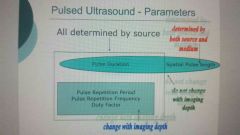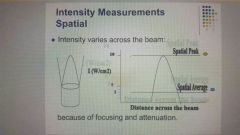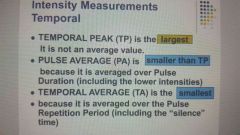![]()
![]()
![]()
Use LEFT and RIGHT arrow keys to navigate between flashcards;
Use UP and DOWN arrow keys to flip the card;
H to show hint;
A reads text to speech;
17 Cards in this Set
- Front
- Back
|
Continuous waves |
With continuous wave Cycles repeat indefinitely |
|
|
Pulsed ultrasound |
With pulse ultrasound groups of cycles (pulses) are produced separately in time |
|
|
Pulse ultrasound parameter |
Additional parameters are needed for pulsed ultrasound: • pulse repetition frequency • pulse repetition period • pulse duration • Duty Factor • spatial pulse length |
|
|
Pulse repetition frequency PRF |
•Pulse repetition frequency are the number of pulses per second • clinical ultrasound use as thousands of pulses per second • pulse repetition frequency does not count cycles per, or per second it counts pulses per second •Determined only by the source can be adjusted by the sonographer by changing the depth of view • prf is reported in units of Hertz PRF kilohertz (kHz) ☆PRF is Inversely Related to Depth of view Pulse ⬆Depth⬇ |
|
|
Pulse repetition period |
It is the time from beginning of one pulse to the beginning of the next. PRP is the reciprocal of PRF •⬆PRF ⬇PRP •PRP is 100-1000 > PD •units: millisecond •typical value: 100 microsecond to 1 millisecond • controlled automatically by the system (sonographer can alter the PRP by adjusting the depth of view)
PRF=1/PRP |
|
|
Pulse repetition period and Depth of view |
Pulse repetition period and depth of view are directly related. Pulse repetition frequency and depth of view are indirectly related. • the maximum distance the sound beam travels into the body is controlled by the sonographer • sonographer cannot modify the transmit time (pulse duration) but they can modify to receive time (by changing depth)
PRP ⬆ DOV ⬆ PRF ⬆DOV⬇ |
|
|
Pulse duration |
It is the time it takes for one pulse to occur. It is the time from the beginning of a pulse to the end of the pulse. • cannot be determined by the sonographer but can choose the frequency transducer •PD= period(time for one cycle) x (# of cycles in the pulse) •Directly proportional to the number of cycles ⬆#cycles ⬆PD • inversely proportional to frequency ⬆ frequency ⬇ PD PD= #cycles / Frequency •Unit: microsecond, ms, or second •typical value: 0.3 to 0.2 microsecond
|
|
|
Duty Factor |
It is the fraction of time that pulse ultrasound is being transmitted. It is the percentage or fraction of time that the system is on. Pulsed ultrasound systems are on for very short period of time it spend most of the time listening • determined by the source •DF=PD/PRP DF%=(PD/PRP)100 •does not have a unit sign •0.2% to 0.5% or 0.002 to 0.005 •Dopper DF 0.5% to 5.0% • DF is inversely related to PRF
PRF⬆PRP⬇DF⬆ |
|
|
Duty factor and continuous wave sound |
For continuous wave sound the duty Factor would be 1 or 100% the system is always transmitting. |
|
|
Spatial pulse length |
It is the length of space that pulse take. Spatial pulse length is given by the length of each cycle times the number of Cycles in the pulse. Important for image resolution. •Unit: (mm) •SPL (mm)= # cycles (n) x wavelength(mm) SPL ⬆ (n)⬆ SPL⬆F⬇ |
|
|
Determination of pulse ultrasound parameters |

|
|
|
Intensities |
It is the power in a wave divided by the area over which the power is applied. Intensity is important to describe the amount of sound sent through the tissue and in discussing bioeffects and safety. •Intensity can be increased by focusing the beam without increasing without increasing the power • intensities are high at the beginning and then decrease towards the end of the pulse •Average Intensity I(mW/cm^2)=P(mW) / A(cm^2) |
|
|
What determines the beam area |
•The beam area is determined by the transducer especially by how it focuses the beam. •Because the transducer sends pulses of sound for a short period of time through different areas determined by the focusing and the distance from the transducer the intensities are not the same throughout the beam and at different times. • therefore and intensities are measured in different ways |
|
|
Spatial and temporal measurements |
In order to measure the different intensities we need to consider time and space. That is when we use spatial measurements and temporal measurements. • In order to measure intensities considering these two parameters of space and time we can estimate for each one the highest intensity (Peak) and the average intensity (average). |
|
|
Spatial intensity |

The sound beam intensity varies at different locations in the beam. • spatial Peak is the maximum value across the beam in other words the greatest intensity across the beam • spatial average is the middle value of all values found across the beam in other words average of all values |
|
|
Temporal intensity |
• temporal Peak is the greatest intensity in a pulse as it passes by • temporal average is the average of intensity during the pulse repetition period. It includes the intensity during the pulse and during the silence or dead time. • pulse average is added to temporal intensity measurement. It is the average for all values found within a pulse. |
|
|
Intensity measurement temporal |

•Temporal Average I (ta)= I (pa) x DF •If the DF is 0.02 (2%), then the I(ta)= two hundredth the I (pa) DF⬆I (ta)⬆ |

